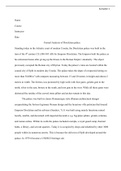Essay
Formal Analysis of Diocletian palace
- Course
- Hist456
- Institution
- Lakeland College ( )
Standing today in the Adriatic coast of modern Croatia, the Diocletian palace was built in the turn of the 4th century CE (300-305 AD) by Emperor Diocletian. The Emperor built the palace as his retirement home after giving up the throne to the Roman Empire voluntarily. The object previously occupie...
[Show more]




